Microsoft Surface Pro 3 Review
by Anand Lal Shimpi on June 23, 2014 3:55 AM ESTBattery Life
Microsoft made no sacrifice in battery capacity in pursuit of Surface Pro 3's thin chassis design. The new tablet features an integrated 42Wh battery just like the previous two models. Charging duties are handled by an external 31W charger with a brand new magnetic connector. Microsoft never seemed to get a good MagSafe clone working in the previous models, so Surface Pro 3 abandons the previous design entirely in favor of something a bit more sensible.
The new connector no longer looks like an oversized MagSafe connector, and instead features a thin plastic insert that mates with the charge port on Surface Pro 3. Charge time hasn't changed, you can fully charge the device in around 2.62 hours:
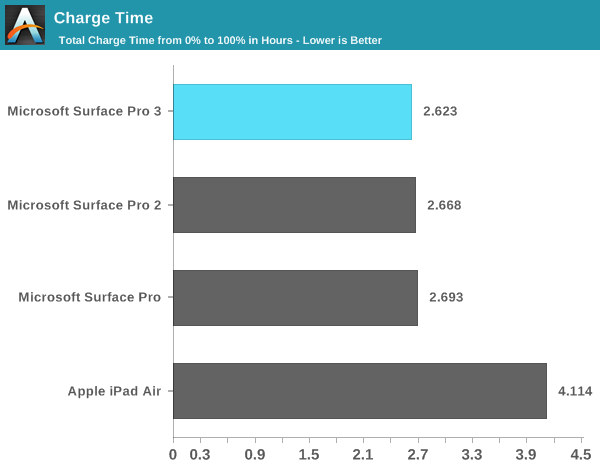
The device-side connector features 40 pins but you only need 12 of them to charge the device. The remaining pins are used for Gigabit Ethernet, USB, DisplayPort (up to 4096 x 2304) and audio. Microsoft seems hell bent on avoiding Thunderbolt at all costs so instead of embracing the standard it has created a custom alternative of its own doing. The benefit to Microsoft's connector is it can obviously deliver more power than Thunderbolt can, the downside is that it can't send PCIe and thus you don't get support for any ultra high bandwidth external storage devices. I still would rather see Microsoft implement Thunderbolt as there's at least an existing ecosystem built around that but here we are three generations into Surface and if we haven't seen it by now I don't think we're ever going to.
The supplied power adapter includes a USB charge port capable of delivering 1A at 5V.
As Surface Pro 3 is designed to be both a laptop and a tablet I've run it through both our Windows laptop battery life tests and our tablet battery life tests.
Laptop Battery Life
As a laptop, Surface Pro 3 delivers comparable battery life to other optimized Haswell ULT designs. I threw in Sony's Vaio Pro 13 into the mix because it has a similar sized battery (37Wh vs. 42Wh) and is one of the most power efficient Windows Ultrabook platforms on the market. Surface Pro 3 manages to deliver similar battery life, which means it's a little less power efficient but the two are within the same range at least.
Compared to Surface Pro 1 and 2, Surface Pro 3 at worst delivers similar battery life and at best increases range on a single charge by up to 20%. We're looking at 3.75 hours - 7.6 hours of notebook usage on a single charge depending on usage.
It's worth noting that there's a substantial advantage in battery life if we look at the 13-inch MacBook Air running OS X. I only mention this because of Microsoft's insistence on comparing Surface Pro 3 to Apple's popular line of notebooks.
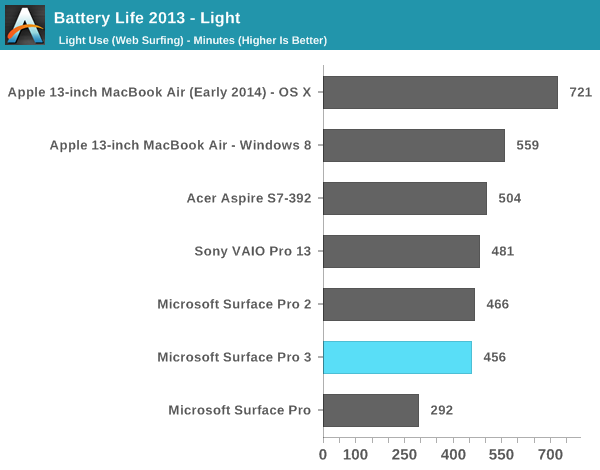

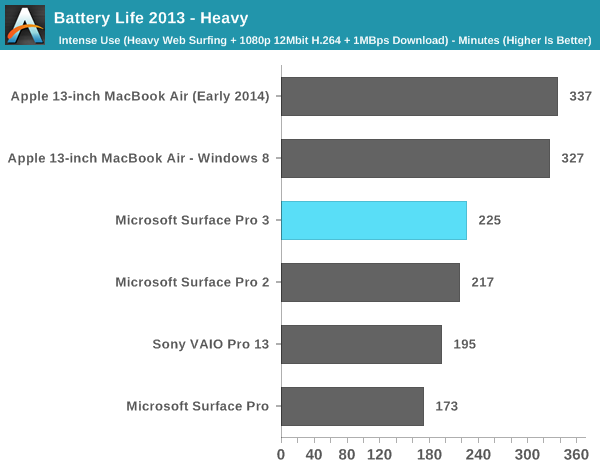
Tablet Battery Life
Tablet workloads are going to be far more display power bound than anything else. Here we see 7.58 - 8.03 hours of continuous usage, a slight regression compared to Surface Pro 2. Video playback remains more power hungry than web browsing, which is something I've noted in previous tablet-evaluations of Intel's Core silicon. I don't believe Intel's Core processors are very optimized for video decode power consumption. If anything is going to change with the move to Broadwell and Core M I suspect video decode power may be it.
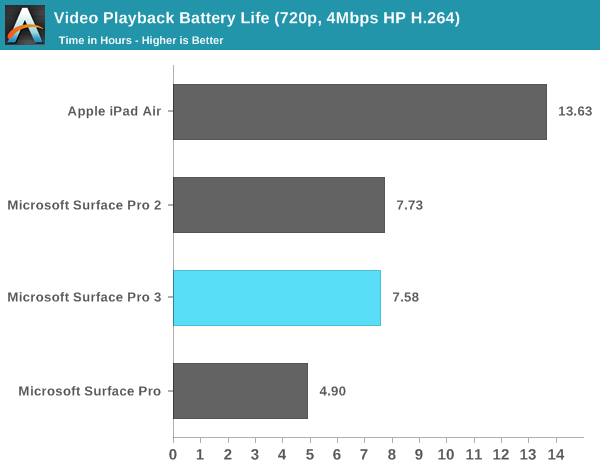
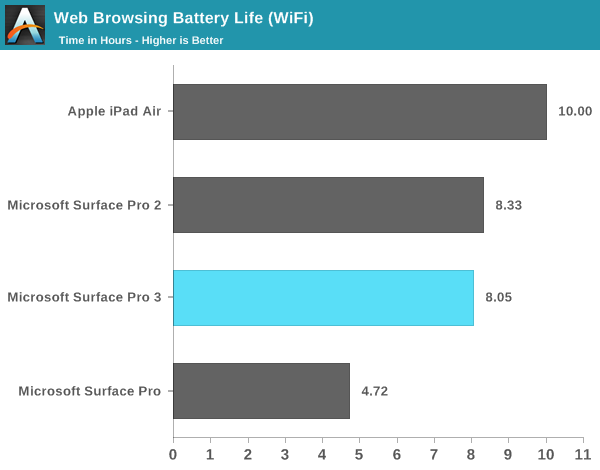


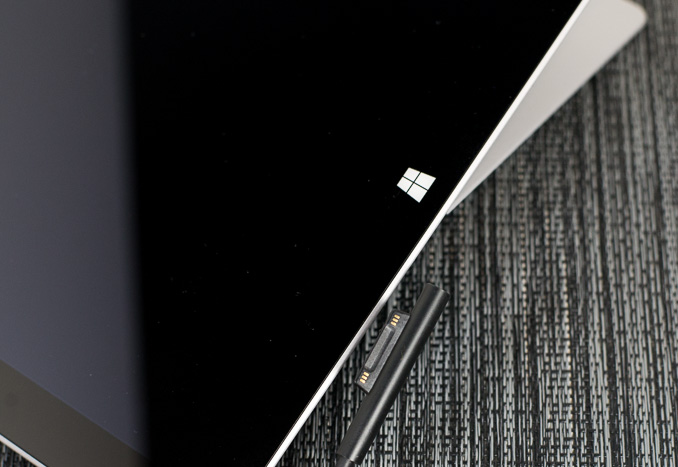
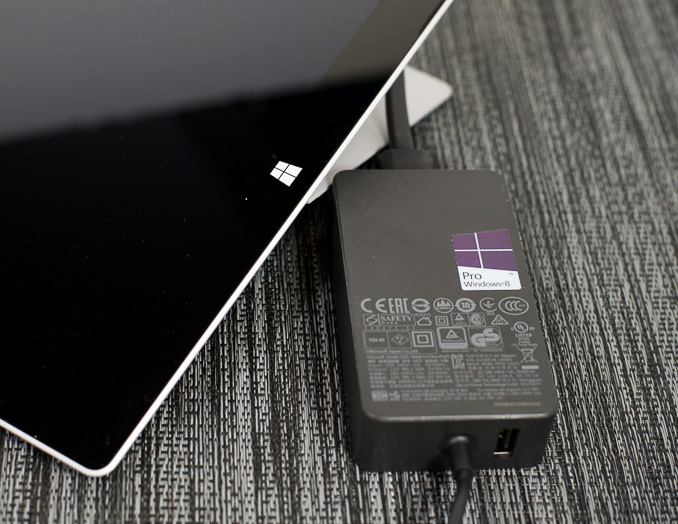








274 Comments
View All Comments
nerd1 - Monday, June 23, 2014 - link
I won't touch anything with that terrible resolution TN screen, even with a stick.TEAMSWITCHER - Monday, June 23, 2014 - link
I have one...and I love it!!I use a desktop as my daily workhorse (OS X and Windows) but always need a laptop for traveling or when I want to get out of the office for a while. I don't need much power to edit source code so I went for extreme portability: I surprise people when I pull it out of the case I'm holding - they mistake it for an iPad.
Yes, the screen is small but workable with full screen apps. The color is good - I never even realized it was a TN screen. The 16 x 9 aspect ratio is nice for Air Playing content to my Apple TV. When not traveling it doubles as my living room computer.
I'm really looking forward to the next iteration of the MacBook Air. A 12" retina screen in the same 2+ lb portable clamshell design with better battery life would be a nice upgrade.
GC2:CS - Monday, June 23, 2014 - link
Nice comparison but well the MacBook Air still stacks up incredibly well in first three categories if we asume that it's the design from late 2010... That's like ancient history ! And still a tablet PC has problems in leapfrogging that in "Weight" and "Thickness". Now let's go back into 2014 and imagine how thin and light can Air go with today technology ? It will be dangerously close to a surfice without type cover ! Yeah it just can't even compare to such laptop.ymcpa - Monday, June 23, 2014 - link
Will that Air have a touchscreen? It will probably get the higher res display finally. The heaviest component is the battery and that really hasn't changed much over the years. They might make it thinner, but with the higher res display, the battery will probably stay the same and the weight of the Air will also probably be the same.basroil - Tuesday, June 24, 2014 - link
OSX doesn't natively support touch screens at all, and their native input pipeline is incapable of differentiating a touch command from a click command.cjs150 - Monday, June 23, 2014 - link
NO SD/MicroSD card slot no sale. $200 more for moving from 64Gb SSD to 128Gb. They are having a laugh.It astounds me that yet again we see a tablet that assumes that everyone can always access everything via WiFi in the cloud. I assume the designers never leave an urban environment and assume that anyone living in sticks is a complete irrelevance
phantomstache - Monday, June 23, 2014 - link
It does have a MicroSD card readerphantomstache - Monday, June 23, 2014 - link
It does have a MicroSD card readerUpSpin - Monday, June 23, 2014 - link
That's an odd upgrade.They switched from Wacom to N-Trig to reduce the costs. I don't think there's any other reason.
Wacom requires an inductive coil 'behind' the screen to work, in front of the screen the capactive touchscreen. N-Trig requires the capactive touchscreen in front of the screen, which gets also used for the pen. So the reduction of parallax would have been able with Wacom, too, because both need the same stuff in front of the display.
The pen lag is most probably a Windows issue. The reason the lag is less in Photoshop is mostly due to the fact that Photoshop uses some proprietary driver to communicate with the pen. At least that's on my Wacom based Tablet PC the case. Once in Photohop the typical Windows specific pen flicks and pen specific events don't work any longer.
The display size on the Surface Pro 3 looks to be much better for a Windows based tablet. It's also great to see they reduced the thickness. But it's an absolute no-go, that they increased the fan noise and fan on-time. Ideally a tablet PC should be dead-silent, thus passively cooled. What MS did on the SP3 is a no-go. Again, the only reason I see is to reduce production costs. You need only one fan instead of 2, only one heat-pipe instead of two, only one heatsink instead of two. Because of the worse thermal design, as can be nicely seen on your thermal images how poor the heat gets spread across the 'surface', they thermally throttle and ramp up the fan. That's a joke.
So I like some changes, but the majority of changes, to reduce cost, made this device worse for my taste. If they continue in this reduction, reducing production costs whatever it takes, the next revision will be total garbage.
ymcpa - Monday, June 23, 2014 - link
The review mentioned why they went with N-trig. Wacom requires a thicker display. N-trig allowed them to reduce the thickness so it became more comparable to tablets. As this review and the one from penny arcade mentioned, there really wasn't any lose in functionality from the switch to N-trig.